2 Configuring the Adapter
This chapter lists system requirements and describes how to configure Oracle Content Server and Siebel for adapter use. It also describes optional configuration, such as scanning via Oracle WebCenter Enterprise Capture, passing additional metadata parameters from Siebel to Content Server, and customizing the adapter IFrame display.
This chapter covers the following topics:
-
Section 2.4, "Configuring Oracle WebCenter Enterprise Capture"
-
Section 2.5, "Configuring Oracle Distributed Document Capture"
-
Section 2.6, "Passing Extra Metadata Parameters From Siebel to Content Server"
-
Section 2.7, "Customizing the Siebel Adapter IFrame Display"
2.1 System Requirements
General requirements for the adapter are listed in this section, and supported configuration and certification information is available at:
The Siebel Adapter for WebCenter Content requires the following:
-
Siebel SIA or SEA. The Siebel Web Client is also required.
-
Oracle WebCenter Content 11g Release 1 (11.1.1 or higher).
-
If implementing scanning functionality, you can use either Oracle WebCenter Enterprise Capture 11g or Oracle Distributed Document Capture 10.1.3.5.1 or later. If using Oracle Distributed Document Capture, you need to install the Oracle UCM 11g Commit Driver.
-
The Siebel Adapter supports the following Content Server search engines. For more information, see Section 2.3.4.
-
Metadata Only Search
-
Database – Full Text Search
-
Oracle Text – Full Text Search
-
2.2 Configuring the Adapter for Content Server
The Content Server configuration procedures are detailed in the following sections:
-
Section 2.2.2, "Upload and Import the Configuration Migration Utility Bundle"
-
Section 2.2.3, "Enable the Siebel Adapter Content Server Components"
2.2.1 Verify Required Content Server Components
Follow these steps to verify that required Content Server components are enabled:
-
Log in to Content Server as an administrator.
-
Click the Configuration for [Instance] link in the Content Server Administration tray.
-
In the Features And Components section, click Enabled Component Details.
-
From the details shown, verify that the following components are enabled. If a component is not listed, enable it.
-
CheckoutAndOpenInNative
-
ConfigMigrationUtility
-
CoreWebdav
-
YahooUserInterfaceLibrary
-
2.2.2 Upload and Import the Configuration Migration Utility Bundle
Follow these steps to upload and import the Siebel adapter bundle:
-
Log back in to Content Server as an administrator.
-
In Content Server, open the Config Migration Admin folder in the Content Server Administration tray, and click the Upload Bundle link.
-
On the Upload Configuration Bundle page, click Browse.
-
Select the SiebelAdapterCMUBundle.zip file, located in the following folder:
ECM_ORACLE_HOME/ucm/Distribution/SiebelEcmIntegration
-
Select the Force overwrite field.
-
Click Upload.
-
On the Configuration Bundles page, select the SiebelIntegrationCmuBundle link. On the Configuration Migration Administration page, select the Overwrites Duplicates field. Select Preview from the item's Actions menu.
-
On the Import Preview page, select Import from the Actions field. (Note that you can ignore messages about skipped dependencies.)
-
Restart Content Server.
2.2.3 Enable the Siebel Adapter Content Server Components
The following Content Server components are provided with the adapter:
Table 2-1 Content Server Components Provided in Siebel Adapter
| Content Server Component | Required | Description |
|---|---|---|
|
SiebelEcmIntegration |
Yes |
This component provides IFrame functionality. |
|
SiebelFilter |
Optional |
This component is an optional part of the Siebel Adapter for Oracle WebCenter Content. It enables filtering of the attachments list based on metadata such as Document Type, Author and Security Group. |
|
SiebelIntegrationSearchDisplay |
Yes |
This component provides searching and IFrame functionality. |
|
SiebelSearchExtension |
Optional |
This component determines whether documents not yet released are displayed in the attachments list.
Note: This feature is available only when Metadata Only Search is used on the Content Server. |
|
SiebelSearchExtraParams |
Optional |
This component enables passing Siebel metadata values to Content Server through the New or Scan buttons. For instructions, see Section 2.6. Specify parameters to pass as configuration variables, as described in Section 2.2.4. |
Follow these steps to enable the components using Component Manager:
-
Log in to Content Server as an administrator.
-
Select Admin Server from the Administration menu. The Component Manager page is displayed.
-
Scroll to the Integration components section.
-
Select the SiebelEcmIntegration and SiebelIntegrationSearchDisplay components to enable them.
-
Optionally, select the SiebelSearchExtension and SiebelSearchExtraParams components. Note that you can disable these components at any time by deselecting them on this page.
-
Click Update.
-
Restart Content Server.
Note:
For information about restarting methods, see the section on starting, stopping, and restarting Content Server in the Oracle Fusion Middleware Administering Oracle WebCenter Content.
2.2.4 Set the Configuration Variables
Follow these steps to configure the adapter configuration variables:
-
From the Administration tray in Content Server, click the Admin Server link.
-
In the side pane, click the General Configuration link.
-
Scroll to the Additional Configuration Variables section, and edit the following entries. (These entries were automatically created when you imported the Configuration Migration Utility Bundle.)
Note:
The default value for all true/false entries is TRUE, except for the AdapterAppDisplayLinks variable, whose default value is FALSE.Table 2-2 Configuration Variable Entries
Entry Description SiebelCssPath=http://siebel_host:port/main.cssUse to identify the Cascading Style Sheet (CSS) file to use for the IFrame. This entry links the Siebel CSS file with the adapter so that changes to the Siebel CSS also affect the IFrame. This is optional but recommended; if not specified, the IFrame uses the default CSS file.
Example Siebel 7.8 URL:
http://siebelserver:port/files/main.cssExample Siebel 8.x URLs:
http://siebelserver:port/callcenter_enu/files/main.csshttp://siebelserver:port/sales_enu/files/main.cssODDCURLPathUse to enable document attachment scanning and importing using Oracle WebCenter Enterprise Capture or Oracle Distributed Document Capture. For configuration instructions, see Section 2.4 and Section 2.5.
For Oracle WebCenter Enterprise Capture (11g) integration
This entry specifies the web address to Oracle WebCenter Enterprise Capture:
Format:
ODDCURLPath=http://capture_host:port/dc-clientExample:
ODDCURLPath=http://capture1:16400/dc-clientFor Oracle Distributed Document Capture (10g) integration
This entry specifies the web address to Oracle Distributed Document Capture:
Format:
ODDCURLPath=http://ODDC_host/ODDC_webcapture_addressExample:
ODDCURLPath=http://xyz/webcapture.aspODDCScanAction=1ODDCScanAction=2Use to configure document attachment scanning and importing using Oracle WebCenter Enterprise Capture (as described in Section 2.4) or Oracle Distributed Document Capture (as described in Section 2.5). In this entry, specify the scan action to be performed, where 1 = Scan and 2 = Import.
AdapterAppFrameLessWindowRequired=trueSpecify if standard browser menu options are hidden in browser windows that open from the IFrame display (true) or displayed (false).
AdapterAppCheckinNewBtnVisible=trueSpecifies if the New button is displayed in the IFrame.
AdapterAppDetachBtnVisible=trueSpecifies if the Detach button is displayed in the IFrame.
AdapterAppAdvSrchBtnVisible=trueSpecifies if the Search button is displayed in the IFrame.
AdapterAppConfigureBtnVisible=trueSpecifies if the Configure button is displayed in the IFrame.
AdapterAppScanBtnVisible=trueSpecifies if the Scan button is displayed in the IFrame.
AdapterAppRefreshBtnVisible=trueSpecifies if the Refresh button is displayed in the IFrame.
AdapterAppAdvSrchUCMUIVisible=trueSpecifies if full Content Server user interface and search access is available when users click the Advanced Search button in the IFrame.
AdapterAppDisplayLinks=falseIf needed, use this variable to replace icons in the IFrame with links, by changing the variable's value to true.
extraSiebelDocParams=parameter,parameter,parameter,...Optionally specify additional parameters to be passed to the New button. See Section 2.6.
Example entry:
extraSiebelDocParams=dDocAccount,xsiebelOrderextraSiebelScanParams=parameter,parameter,parameter,...Optionally specify additional parameters to be passed to the Scan button. See Section 2.6.
Example entry:
extraSiebelScanParams=dDocAccountNote:
You can override the entries that determine if the New, Detach, Search, Configure, Scan, and Refresh buttons are displayed by specifying an alternate display mode, as described in Section 2.7.2.Note:
You can specify the default columns to be displayed to users in the IFrame. (When the user clicks Reset in the Configure Fields for Display screen, default columns are listed in the Main Information section of the screen.)Open the config.cfg file and set the value of the SiebelDefaultDisplayColumns configuration variable as a comma-delimited list containing the default fields.
The additional column defaults are title, author, size, and date. To override these additional columns, populate this variable with comma-delimited Content Server metadata field names. For example, the list might include:
dDocTitle,dDocType,dDocAuthor,dInDateNote:
To avoid an issue with the Siebel Adapter for Content Server, in which the Content Server login page displays in the Siebel page instead of the IFrame, add the following entry to the Content Server config.cfg file:AllowContentServerInAnyDomains=1Be aware that setting the AllowContentServerInAnyDomains variable to 1 allows Content Server pages to be opened in IFrames, which could pose a potential security issue.
-
Restart Content Server.
2.3 Configuring the Adapter for Siebel
Follow the steps described in this section to configure the Siebel side of the adapter.
The Siebel configuration procedures include the following:
Keep the following points in mind during Siebel configuration:
-
Siebel adapter Siebel SIF files can be found at the following location after an install:
middleware/Oracle_ECM1/ucm/Distribution/SiebelEcmIntegration -
Ensure that you are compiling to and testing on the same Siebel Repository file (.SRF).
-
A typical method is to import the SIF file into the local Siebel database and test it locally. When ready, you can check in the objects to the Siebel server, compile objects, and generate browser scripts.
-
New browser scripts that are generated must reside in the appropriate production location (for example, local client/PUBLIC/ENU and/or server Web client (SWE)/PUBLIC/ENU folders).
-
Performing the Siebel configuration steps in this section automatically disables display of the corresponding Siebel File System Applets. This occurs when importing the SIF file, which deactivates specific File System attachment applets. If needed, reactivate these applets to display Siebel File System attachments, such as during a migration process. For information on activating and deactivating applets, see Appendix A.
-
When the Siebel Adapter for WebCenter Content is configured, Siebel attachments that customers have migrated from Siebel File Systems to Content Server and previously accessed with Siebel EAI or EIM Web services are no longer available. However, these migrated documents could now be accessed using Content Server Web services.
2.3.1 Lock Siebel Objects
The SIF archive file contains changes to multiple Siebel objects, including Projects, Applets, Views, Business Components, and browser scripts. Before importing the SIF file, follow these steps to lock objects to be modified by the import:
-
Log in to Siebel Tools with User ID: SADMIN and Connect to: Local.
Note:
Ensure that you are modifying the correct .SRF repository file. -
In the Object Explorer of Siebel Tools, select Project.
-
From the Query menu, select New Query (Ctrl+Q).
-
Submit the first query by entering the following text into the Name field and pressing Enter:
Account OR Account ?SSE? OR Asset Management OR Contact OR Contact ?SSE? OR ERM Unified Help Desk OR FINS Call Reports OR FINS Call Reports ?SSE? OR FINS INS Claims OR FINS INS Claims Appraisals/Bills/Attachments OR Oppty OR Oppty ?SSE? OR Order Entry OR Quote OR Quote ?UI?Note:
If you choose to copy and paste the text string, be sure to first paste the copied text into an ascii editor (such as Notepad) and remove any carriage returns before pasting into the Name field. -
Select the Locked field for all objects.
-
Start another query by selecting New Query from the Query menu (Ctrl+Q). Enter the following text into the Name field and press Enter:
Service OR Service ?SSV? OR VERT CUT Common OR PS Project Management OR PS Project Management ?SSE? OR Activity OR Activity ?SSE? OR PUB Case OR PUB Evidence OR PUB HLS Incident OR PUB HLS Physical Terrorism OR PUB Lead OR FINS Call Reports2 -
Select the Locked field for all objects.
Note:
Appendix A provides information about which objects are locked. This can be useful if you encounter issues when locking Siebel projects.
2.3.2 Import the SIF File
Follow these steps to import Siebel Adapter for WebCenter Managed Attachments objects into Siebel from a Siebel Archive File from a Siebel archive file using the Import Wizard:
Caution:
On certain custom Siebel configurations, importing the SIF file using the merge option (as described in this procedure) could result in fields, user properties, and joins from custom Siebel configurations being overwritten.-
From the Tools menu, choose Import From Archive.
-
In the Select Archive To Import dialog box, select the appropriate .sif archive file, and click Import. Available SIF files include:
-
Siebel_SEA_7.x_UCM_Attachments_YYYYMMDD.sif
-
Siebel_SIA_8.x_UCM_Attachments_YYYYMMDD.sif
-
Siebel_SIA_7.x_UCM_Attachments_YYYYMMDD.sif
-
Siebel_SEA_8.x_UCM_Attachments_YYYYMMDD.sif
-
-
The SIF file's contents are displayed in the Import Wizard - Preview screen. Ensure that the Merge option (middle option) from the Conflict Resolution options is selected, and click Next. (This option merges the SIF file changes to existing Siebel Objects.)
-
The wizard displays any conflicting objects found. Click Next.
-
A dialog box lists the changes to be made to the repository, and prompts you to proceed. Click Yes.
-
A summary is displayed. Click Finish.
2.3.3 Compile Locked Projects
Before testing the modified projects, follow these steps to compile them:
-
Select Options from the View menu.
-
In the Development Tools Options screen, select the Scripting tab.
-
In the Browser script compilation folder field, enter a path as follows:
Client Install Folder/PUBLIC/ENU
For example, on Windows Drive_letter:\Siebel_install_folder_path\client\PUBLIC\enu
-
Select Project in the Object Explorer, locate the Manage Attachments (UCM) project and lock it.
-
From the Tools menu, choose Compile Projects.
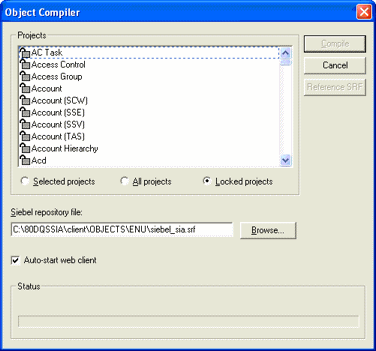
Description of the illustration ''siebel_config6.gif''
-
In the Object Compiler screen, select Locked projects.
-
Verify that the correct repository is selected in the Siebel repository file field. This repository file must exist in the Web Client installation folder.
-
Click Compile. (Note that compiling may take a while.)
2.3.4 Configure the IFrame URL in the Siebel Web Client
Follow the steps in this section to configure a symbolic URL in the Siebel Web client to the Managed Attachments IFrame. (A symbolic URL is a type of link that references the Content Server search results page.)
-
Launch the Web client, logging in with the User ID: SADMIN.
-
Choose Sitemap from the Navigate menu. The site map of the Siebel Web Client Application is displayed.
-
From the list of screens, click the Administration- Integration link, then the Symbolic URL Administration link.
-
From the Host Administration field, select Symbolic URL Administration.
-
Click New to create a new record.
-
Complete the following fields for the URL. With the new URL selected in the Symbolic URL table, a Symbolic URL Arguments pane becomes displayed.
Field Value to Enter Name UcmServUrlURL http://Content_Server_URL/_p/cc-embedded(example:
http://content-server-name.domain:port-number/cs/idcplg/_p/cc-embedded)Fixup Name InsideAppletSSO Disposition IFrameNote:
In certain demonstration environments, enteringUcmServUrlin the Name field results in an error. If this occurs, enter the following:UcmServUrl_Demo -
In the Symbolic URL Arguments pane, create new argument records by entering the following values. To create a new record, click New, select the new record, and specify its values. Be sure to navigate away from the last record entered to ensure it is saved to the database.
An example of a Symbolic URL follows. (Note that this example URL is separated onto multiple lines for display purposes only, with argument names in bold for clarity.)
http://content-server-name.domain:port-number/cs/idcplg/_p/cc-embedded? IdcService=GET_SEARCH_RESULTS_FORCELOGIN& siebelEntityField=xsiebelContact& siebelEntityValue=1LS-AF98& QueryText=xsiebelContact+%3cmatches%3e+%601LS-AF98%60& SearchQueryFormat=Universal& ResultTemplate=SIEBEL_SEARCH& coreContentOnly=1& SortField=dInDate& SortOrder=Desc& SearchEngineName=DATABASE.METADATA& ResultCount=20
Name Required Argument Argument Type Argument Value Append as Argument Substitute in Text Sequence # IdcService N Constant GET_SEARCH_RESULTS_FORCELOGIN Y N 1 siebelEntityField N Field SiebelEntityName Y N 2 siebelEntityValue N Field Id Y N 3 QueryText N Field QueryText Y N 4 SearchQueryFormat N Constant Universal Y N 5 ResultTemplate N Constant SIEBEL_SEARCH Y N 6 coreContentOnly N Constant 1 Y N 7 SortField N Constant dInDate Y N 8 SortOrder N Constant Desc Y N 9 SearchEngineName N Constant DATABASE.METADATA Y N 10 ResultCount N Constant 6 (See Section 2.3.4.1).
Y N 11 IFrameSRC N Command IFrame Height=280 Width=100% (See Section 2.3.4.1).
Y N 12 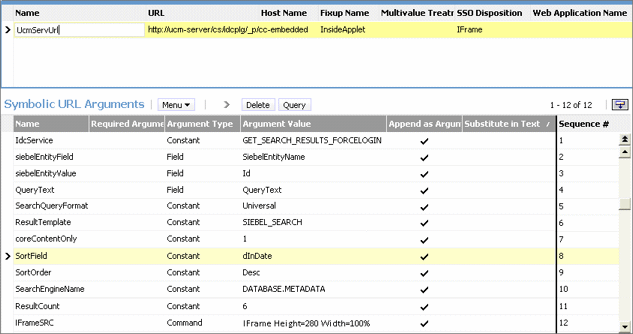
Description of the illustration ''siebel_config7.gif''
2.3.4.1 Configure the IFrame Height
The size of the IFrame is based on the ResultCount and IFrameSRC height settings defined in the Symbolic URL.
-
ResultCount determines the number of results that display on a results page before pagination controls are added at the bottom of the screen.
-
IFrameSRC height determines the height (in pixels) of the IFrame.
If the ResultCount setting causes the IFrame display to exceed the height, a vertical scroll bar is displayed. If users scroll to the bottom, the header information may become hidden.
For this reason, it is recommended that you adjust the ResultCount and IFrameSRC height settings in combination so that no scroll bar is displayed. Ensure that the IFrame height accommodates the result count. A recommended setting combination is an IFrame height setting of 280 and ResultCount setting of 6.
2.3.5 Test the Siebel Configuration
-
Log out of the Web client, then log in again to view the Managed Attachments IFrame embedded in the Attachments tab.
Tip:
To access Views, choose Sitemap from the Navigate menu in the Web client. This displays opportunities, orders, and other options with their child Views and attachment Views. -
Test the changes locally. After testing is successful, ensure that the objects, including generated browser scripts, are synchronized with the Siebel server.
Note:
If you encounter technical issues in configuring this adapter, on either the Content Server side or the Siebel side, log a service request using My Oracle Support.Setting AllowContentServerInAnyDomains
If the Content Server login page displays in the Siebel page instead of the IFrame, setting AllowContentServerInAnyDomains=1 in the Content Server config.cfg fixes the issue.
Note:
Be aware that setting the AllowContentServerInAnyDomains variable to 1 allows Content Server pages to be opened in IFrames, which could pose a potential security issue.2.4 Configuring Oracle WebCenter Enterprise Capture
This section covers the following topics:
-
Section 2.4.1, "About Document Scanning Using Oracle WebCenter Enterprise Capture"
-
Section 2.4.2, "Configure Oracle WebCenter Enterprise Capture for the Siebel Adapter"
-
Section 2.4.3, "Configure Content Server for WebCenter Enterprise Capture via the Adapter"
-
Section 2.4.4, "Test the WebCenter Enterprise Capture Via Siebel Adapter Configuration"
Note:
This section describes scanning via Managed Attachments using Oracle WebCenter Enterprise Capture 11g. For information about scanning using Oracle Distributed Document Capture 10g, see Section 2.5.2.4.1 About Document Scanning Using Oracle WebCenter Enterprise Capture
The Oracle WebCenter Enterprise Capture application allows an application such as the Siebel Adapter to direct it to scan a document and pass in document metadata values. This allows users to scan a document or import a file (image or non-image file such as PDF or Microsoft Word file) from the Managed Attachments IFrame and attach it to the selected Siebel record.
When configured for the Siebel Adapter, document scanning works like this:
-
A Scan button is added to the Managed Attachments IFrame. The user clicks the button, and selects a Document Classification and Security Group, which are assigned to an Oracle WebCenter Enterprise Capture client profile. For example, the user might select a classification of Identity Documents to scan a photocopy of a driver's license or passport. (An Oracle WebCenter Enterprise Capture client profile specifies scanning, importing, and indexing settings.)
-
When the user clicks Scan Document, Oracle WebCenter Enterprise Capture's client launches in a new window and passes in parameters such as the client profile to be used and the Siebel entity value for later attachment.
-
Within the Oracle WebCenter Enterprise Capture client, the user reviews the document, makes changes as needed, completes any metadata fields configured in the client profile, and then releases the batch. Releasing the batch commits the new document to the Content Server using a Capture commit profile configured to commit to WebCenter Content. (A Capture commit profile configured for Content commit specifies connection information and field mappings between WebCenter Enterprise Capture and Content Server metadata fields.)
-
Upon successful batch release, the user returns to the Managed Attachments IFrame and refreshes the display to view the newly scanned document or imported file.
2.4.2 Configure Oracle WebCenter Enterprise Capture for the Siebel Adapter
Follow these steps to configure attachment scanning on the Oracle WebCenter Enterprise Capture side:
-
If needed, configure Single Sign-on (SSO) for Oracle WebCenter Enterprise Capture.
As long as the Siebel adapter solution and WebCenter Enterprise Capture are configured in Oracle Access Manager (OAM), Capture users can be authenticated via SSO.
-
In the Capture Workspace Console, add metadata fields to a selected workspace for capturing values for new documents, as shown in Figure 2-1. For details, see the section on the Capture Workspace Console in Oracle Fusion Middleware Managing Oracle WebCenter Enterprise Capture.
-
Create metadata fields for values you want to save with attached documents on the Content Server. For example, you might configure Doc Type and Security Group choice list metadata fields for users to select from standard settings.
-
Create a metadata field to contain the Siebel entity value. Name the field based on the Siebel entity you are using, listed in the following table.
Identifier dDocAuthor dDocAccount xAccountId xsiebelAcct xsiebelActivity xsiebelArrest xsiebelAsset xsiebelCallRpt xsiebelCase xsiebelClaim xsiebelContact xsiebelEvidence xsiebelGroup xsiebelIncident xsiebelLead xsiebelOffense xsiebelOpprnty xsiebelOrder xsiebelProject xsiebelQuote xsiebelSuspect xsiebelSvcReq Note:
Capture allows you to map DocAuthor as a custom metadata field. This ensures that the documents can have an author other than the default author.Figure 2-1 WebCenter Enterprise Capture, Metadata Fields

Description of ''Figure 2-1 WebCenter Enterprise Capture, Metadata Fields''
Note:
The Siebel identifier metadata fields (named xsiebel<entity>, as in xsiebelContact and xsiebelAcct) store Siebel entity values used for linking attachments to Siebel entities. Because they are not stored as regular metadata fields, they are not searchable and administrators configuring profiles should not treat them as regular metadata fields. (By default, these identifier fields are not visible to users in WebCenter Content. While users can enter search values into the fields if displayed, matching documents will not be found by the Content Server search engine.)Users can attach documents to entities by entering entity row IDs into the Siebel identifier fields as a comma-separated list. In this case, Managed Attachments stores the values in a separate database table.
-
-
On the Workspace's Classification tab, create a document profile for the Siebel metadata fields, as shown in Figure 2-2. For details, see the section on document profiles in Oracle Fusion Middleware Managing Oracle WebCenter Enterprise Capture.
Figure 2-2 WebCenter Enterprise Capture, Document Profile
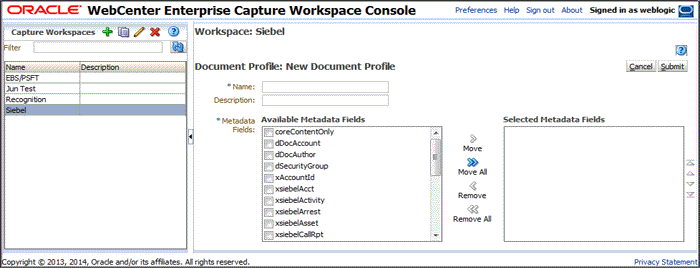
Description of ''Figure 2-2 WebCenter Enterprise Capture, Document Profile''
Note:
Typically, you would not select the Siebel identifier field (xsiebelContact, for example) for display to users. If you choose to display it, lock it under the metadata settings to prevent users from changing the value. -
On the Capture tab, create a client profile, as shown in Figure 2-3. Later, you associate this client profile with one or more document classifications, so that when a user selects a classification, the associated client profile's settings are used. For details, see the section on client profiles in Oracle Fusion Middleware Managing Oracle WebCenter Enterprise Capture.
-
On the General Settings train stop, select 2 - Capture and Index in the Profile Type field. This capture type includes indexing, and scans or imports pages into a single document in a batch. Specify a profile name and batch prefix for the client profile.
-
On the Document Indexing Settings train stop, select the Siebel document profile you created in step 3. You can optionally select the database lookups and choice lists that you created in the Metadata tab.
-
Click Submit to save the client profile.
Figure 2-3 WebCenter Enterprise Capture, Client Profile
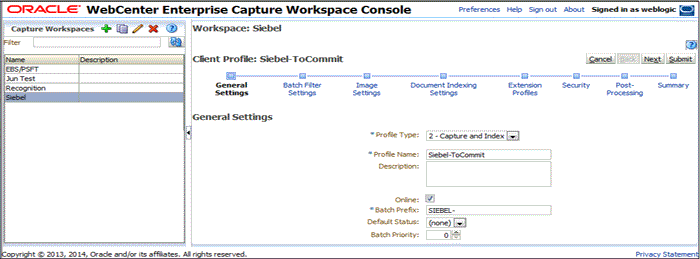
Description of ''Figure 2-3 WebCenter Enterprise Capture, Client Profile''
-
-
On the Commit tab, create an Oracle WebCenter Content commit profile to commit the scanned or imported documents to the Content Server when users release a completed batch. See Figure 2-4.
This commit profile specifies how to connect to the Content Server, and how the Siebel and Capture values are passed to the Content Server. For information about creating Oracle WebCenter Content commit profiles, see the section on committing profiles in Oracle Fusion Middleware Managing Oracle WebCenter Enterprise Capture.
-
Select WebCenter Content from the Commit driver drop-down list.
-
On the Login tab, specify settings for logging in to the Content Server instance. (The other tabs become active after you log in.)
-
On the Check-In tab, specify where to make documents visible, how to name documents and assign Type, Security Group, and Account metadata values.
-
On the Field Mappings tab, specify how to write Capture metadata values to the Content Server fields.
Note:
You must map the Siebel entity field you created in step b, as it is required to attach the new Content Server document to the Siebel record. -
On the Options tab, specify additional settings.
Figure 2-4 WebCenter Enterprise Capture, Field Mappings for a Content Commit Profile

Description of ''Figure 2-4 WebCenter Enterprise Capture, Field Mappings for a Content Commit Profile''
-
2.4.3 Configure Content Server for WebCenter Enterprise Capture via the Adapter
Follow these steps to configure attachment scanning on the Content Server side:
-
On Content Server, edit the following configuration variables for Oracle WebCenter Enterprise Capture, if you have not done so. See Section 2.2.4.
-
ODCURLPath=http://capture_host:port/dc-client -
ODDCScanAction=ODDC Scan Action
-
AdapterAppScanBtnVisible=true
-
-
Restart Content Server.
-
On the Content Server, configure document classification and scan types.
-
From the Administration tray in the Content Server, click the Admin Applets link.
-
Select the Configuration Manager applet. The Configuration Manager is displayed.
-
Click the Views tab, select DocClassView from the alphabetical list, and click Edit Values.
-
-
In the Edit Values dialog box, click Add and specify the document classification and the corresponding client profile. Note that documentClassification entries must be unique, but a client profile can be used multiple times. Click Close when done.
-
From the Options menu, select Publish schema to publish the data.
2.4.4 Test the WebCenter Enterprise Capture Via Siebel Adapter Configuration
Follow these steps to test the configuration as an end-user. For details about scanning using Oracle WebCenter Enterprise Capture as an end-user, see Oracle Fusion Middleware Using Oracle WebCenter Enterprise Capture:
-
Refresh the Managed Attachments IFrame results page. You should see a Scan button beside the New button.
-
Click Scan. On the Scan Document page, select a document classification and security group, then click Scan Document. The Oracle WebCenter Enterprise Capture client launches.
Notice that the URL reflects the settings you specified to run the client. It also passes the client profile, scan action (1 = Scan and 2 = Import), and metadata data consisting of the Siebel entity and its value (for example, xsiebelContact=1LS-AF98).
-
Within the Oracle WebCenter Enterprise Capture client, review, index, and release the document's batch.
-
Return to the Managed Attachments IFrame and click Refresh. The newly scanned document or imported scanned file should be displayed in the list. (It may take a few minutes to be displayed.)
2.5 Configuring Oracle Distributed Document Capture
This section covers the following topics:
-
Section 2.5.1, "About Document Scanning Using Oracle Distributed Document Capture"
-
Section 2.5.2, "Configure Oracle Distributed Document Capture For the Siebel Adapter"
-
Section 2.5.3, "Configure Content Server for Distributed Document Capture Via the Adapter"
-
Section 2.5.4, "Test the Distributed Document Capture Via Siebel Adapter Configuration"
Note:
This section describes scanning via Managed Attachments using Oracle Distributed Document Capture 10g. For information about scanning using Oracle WebCenter Enterprise Capture 11g, see Section 2.4.2.5.1 About Document Scanning Using Oracle Distributed Document Capture
The Oracle Distributed Document Capture application allows an application such as the Siebel Adapter to direct it to scan a document and pass in document index values. This allows users to scan documents or import scanned image files from the Managed Attachments IFrame and attach them to the selected Siebel record.
When configured for the Siebel Adapter, document scanning works like this:
-
A Scan button is added to the Managed Attachments IFrame. The user clicks the button, and selects a document classification, which is assigned to an Oracle Distributed Document Capture scan profile. For example, the user might select a classification of Identity Documents to scan a photocopy of a driver's license or passport. (An Oracle Distributed Document Capture scan profile specifies scanning, importing, and indexing settings.)
-
When the user clicks Scan Document, Oracle Distributed Document Capture's remote client launches in a new window, automatically authenticates and logs in the user, and passes in parameters such as the scan profile to be used and the Siebel entity value for later attachment.
-
Within the Oracle Distributed Document Capture client, the user reviews the document, makes changes as needed, completes any index fields configured in the scan profile, then sends the batch. Sending the batch commits the new document to Content Server using an Oracle 11g UCM commit profile specified for the scan profile. (A Capture UCM commit profile specifies connection information and field mappings between Capture and Content Server metadata fields.)
-
Upon successful sending, the user returns to the Managed Attachments IFrame and refreshes the display to view the newly scanned document or imported scanned image file.
2.5.2 Configure Oracle Distributed Document Capture For the Siebel Adapter
Follow these steps to configure attachment scanning on the Oracle Distributed Document Capture side:
-
Ensure that Oracle Distributed Document Capture is set for automatic login (optional).
On the System Settings tab of the Distributed Document Capture Server Configuration application shown in Figure 2-5, select Web Server Authenticated Access from the Authentication Methods options. This allows the client to launch automatically without users needing to log in. For details, see the section on authentication in the Installation Guide for Oracle Distributed Document Capture.
Figure 2-5 Distributed Document Capture Server Configuration, System Settings Tab
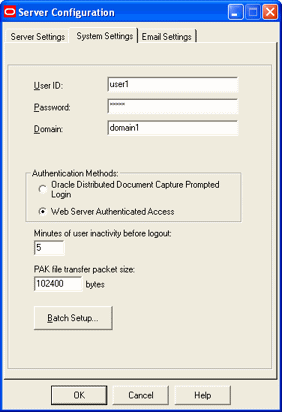
Description of ''Figure 2-5 Distributed Document Capture Server Configuration, System Settings Tab''
-
In Capture Administration, add index fields to a selected file cabinet for capturing values for new documents, as shown in Figure 2-6. For details, see the section on Capture Administration in the Administrator's Guide for Oracle Distributed Document Capture:
-
Create index fields for values you want saved with attached documents on the Content Server. For example, you might configure Doc Type and Security Group pick-list index fields for users to select from standard settings.
-
Create an index field to contain the Siebel entity value. Name the field based on the Siebel entity you are using, listed in the following table:
Identifier xsiebelAcct xsiebelActivity xsiebelArrest xsiebelAsset xsiebelCallRpt xsiebelCase xsiebelClaim xsiebelContact xsiebelEvidence xsiebelGroup xsiebelIncident xsiebelLead xsiebelOffense xsiebelOpprnty xsiebelOrder xsiebelProject xsiebelQuote xsiebelSuspect xsiebelSvcReq
Figure 2-6 Capture Administration, Index Fields

Description of ''Figure 2-6 Capture Administration, Index Fields''
-
-
In Oracle Distributed Document Capture's Profile Administration, create a scan profile, as shown in Figure 2-7. Later, you associate this scan profile with one or more document classifications, so that when a user selects a classification, the associated scan profile's settings are used. For details, see the section on scan profiles in the Administrator's Guide for Oracle Distributed Document Capture.
-
On the General pane, select 2 - Scan and Index Documents in the Scanning Type field. This scanning type includes indexing, and scans or imports pages into a single document in a batch. Specify a file cabinet and batch prefix.
-
On the Document Indexing pane, move all fields you want displayed to users to the Selected Fields box.
Note:
Typically, you would not select the Siebel identifier field (xsiebelContact, for example) for display to users. If you choose to display it, lock it on the Field Properties pane to prevent users from changing the value. -
On the Field Properties, Auto Populate, and Database Lookup panes, configure any pick-lists, database lookups, or autopopulating needed for indexing. Save the scan profile.
Figure 2-7 Scan Profiles, Oracle Distributed Document Capture Profile Administration
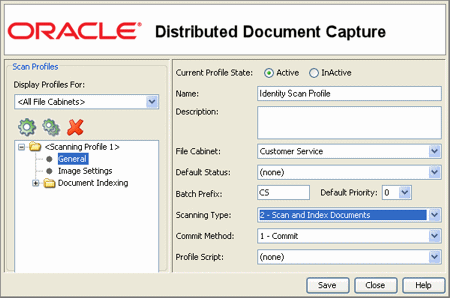
Description of ''Figure 2-7 Scan Profiles, Oracle Distributed Document Capture Profile Administration''
-
-
In Capture Administration, create an Oracle UCM 11g commit profile to commit the scanned or imported documents to Content Server when users send a completed batch. See Figure 2-8.
This commit profile specifies how to connect to the Content Server, and how the Siebel and Capture values are passed to the Content Server. For information about creating Oracle UCM 11g commit profiles, see the section on committing profiles in the Administrator's Guide for Oracle Distributed Document Capture:
-
Select Oracle UCM 11g Commit Driver in the Commit Driver field. Click Configure adjacent to the Commit Driver field.
-
On the Login tab, specify settings for logging in to the Content Server instance. (The other tabs become active after you log in.)
-
On the Check-In tab, specify how to name documents and assign Type, Security Group, and Account values.
-
On the Field Mappings tab, map Capture fields to Content Server fields.
Note:
You must map the Siebel entity field you created in step b, as it is required to attach the new Content Server document to the Siebel record. -
Activate the Siebel-UCM commit profile.
Figure 2-8 Capture Administration, Oracle UCM 11g Commit Settings
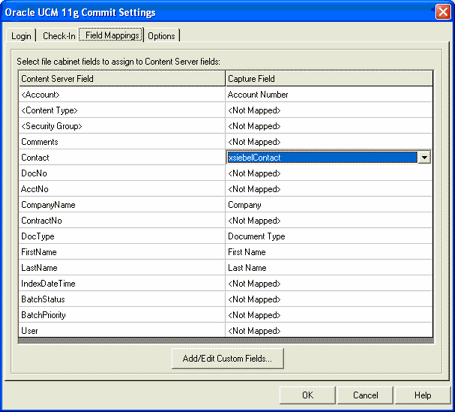
Description of ''Figure 2-8 Capture Administration, Oracle UCM 11g Commit Settings''
-
2.5.3 Configure Content Server for Distributed Document Capture Via the Adapter
Follow these steps to configure attachment scanning on the Content Server side:
-
On Content Server, edit the following configuration variables for Oracle Distributed Document Capture, if you have not done so. See Section 2.2.4.
-
ODDCURLPath=http://ODDC_host/ODDC_webcapture_address -
ODDCScanAction=ODDC Scan Action
-
AdapterAppScanBtnVisible=true
-
-
Restart Content Server.
-
On Content Server, configure document classification and scan types.
-
From the Administration tray in Content Server, click the Admin Applets link.
-
Select the Configuration Manager applet. The Configuration Manager is displayed.
-
Click the Views tab, select DocClassView from the alphabetical list, and click Edit Values.
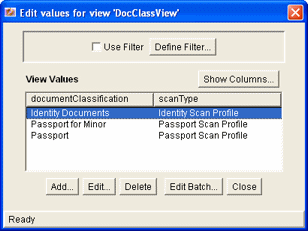
Description of the illustration ''doc_class1.gif''
-
-
In the Edit Values screen, click Add and add document classification and their corresponding scan profile. Note that the documentClassification entries must be unique, but a scan profile can be used multiple times. Click Close when done.
-
From the Options menu, select Publish schema to publish the data.
2.5.4 Test the Distributed Document Capture Via Siebel Adapter Configuration
Follow these steps to test the configuration as an end-user. For details about scanning using Oracle Distributed Document Capture as an end-user, see the Oracle Distributed Document Capture User's Guide:
-
Refresh the Managed Attachments IFrame results page. You should see a Scan button beside the New button.
-
Click Scan. In the Scan Document page, select a document classification and click Scan Document. The Oracle Distributed Document Capture client launches.
Notice that the URL reflects the settings you specified to run the client. It also passes the scan profile, scan action (1 = Scan and 2 = Import), and index data consisting of the Siebel entity and its value (for example, xsiebelContact=1LS-AF98).
-
Within the Oracle Distributed Document Capture client, review, index, and send the document's batch.
-
Return to the Managed Attachments IFrame and click Refresh page. The newly scanned document or imported scanned image file should be displayed in the list. (It may take a few minutes to be displayed.)
2.6 Passing Extra Metadata Parameters From Siebel to Content Server
As part of an adapter configuration, you can pass one or more metadata values from Siebel to Content Server for populating New and Scan button URLs within the Siebel IFrame. For example, whenever a user checks in a new document using the New or Scan button, you might pass a Siebel account name for use in check-in.
Here's how it works:
-
To pass values, you need a Siebel field and a Content Server metadata field.
-
Two configuration variables are provided: one for new documents and the other for scanning documents. You set these variables to the metadata field(s) to populate on the Content Server side.
-
You add arguments to the symbolic URL (with the prefix extra added to the variable name) that link the Siebel and Content Server fields, so that they are appended to the New or Scan button URL. When the IFrame is displayed, the application searches the URL for extra parameter variables and uses their assigned values to populate New or Scan button actions.
-
Depending on configuration, extra values being passed may be visible or hidden from users checking in or scanning documents. For example, you might hide an account number, but for another value, you might populate a dropdown field and allow users to change the value.
Configuring extra metadata parameters involves the following main steps:
2.6.1 Configure Content Server for Extra Parameters
Follow these steps to configure extra parameters on the Content Server side:
-
Ensure that the SiebelSearchExtraParams component is enabled. See Section 2.2.3.
-
Set the extraSiebelDocParams and extraSiebelScanParams configuration variables.
Specify the Content Server field or fields to populate. Define extraSiebelDocParams to pass values using the New button, and extraSiebelScanParams to pass values using the Scan button. For information about configuration variables, see Section 2.2.4.
For example, to populate the Content Server Account metadata field for new and scanned documents, specify the following:
-
extraSiebelDocParams=dDocAccount
-
extraSiebelScanParams=dDocAccount
Note:
If specifying multiple Content Server fields for a variable, separate them with a comma. For example:extraSiebelDocParams=dDocAccount,xsiebelOrder
extraSiebelScanParams=dDocAccount,dDocType
-
-
Update profiles as needed to accommodate the passed values (without the extra prefix).
-
If passing values using the New button, update the Content Server content profile to display the metadata field you specified, if needed.
-
If passing values using the Scan button, update the client profile to display the index field, if desired. (The index field must exist for the workspace being used.) In the commit profile, map the index field to the appropriate Content Server metadata field.
-
2.6.2 Configure Siebel for Extra Parameters
Follow these steps to configure extra parameters on the Siebel side:
-
Add a Siebel field to hold the value to pass. For example, you might add a field called UcmAccount to the Contact business component, as shown in the following figure.
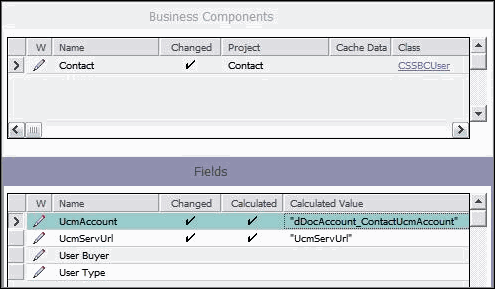
Description of the illustration ''extraparams1.gif''
-
On the symbolic URL, add an argument for the field you created in step 1, including the extra prefix (extradDocAccount in the following example, which is the Content Server metadata variable name of dDocAccount with the extra prefix).

Description of the illustration ''extraparams3.gif''
-
Compile the business component.
2.7 Customizing the Siebel Adapter IFrame Display
You can customize the Siebel Adapter in the ways described in the following sections:
2.7.1 Add Custom Buttons
Follow these steps to add a custom button to the IFrame to implement an additional function:
-
Using Component Manager, create a custom component. Create an include resource that overrides the following resource includes:
-
js_custom_siebel_functions
-
custom_configurable_btn_bar
-
js_custom_configurable_btn_bar
-
-
After applying these resource includes, enable the component in Content Server.
The super.js_custom_siebel_functions must be included for the main button bar to display. This include adds a javascript listener attached to the custom button. The YAHOO.oracle.ucm.adapter.extension is the YUI namespace which helps in detecting and preventing name conflicts.
<@dynamichtml js_custom_siebel_functions@>
<$include super.js_custom_siebel_functions$>
<script type="text/javascript">
//namespace definition
YAHOO.namespace("YAHOO.oracle.ucm.adapter.extension");
/**
* Function for custom functionality added to the existing adapter.
*
*/
YAHOO.oracle.ucm.adapter.extension.customFunctionListener=function(){
//custom code goes in here
alert("You have your custom functionality running");
};
</script>
<@end@>
The super include must be present. This code makes the button appear in the user interface.
<@dynamichtml custom_configurable_btn_bar@>
<$include super.custom_configurable_btn_bar$>
<a id="customBtn"
href="http://hostname/pages/editpage.action#" >Custom Button</a>
<@end@>
js_custom_configurable_btn_bar
This code associates the listener function with the button code.
<@dynamichtml js_custom_configurable_btn_bar@>
<$include super.js_custom_configurable_btn_bar$>
YAHOO.util.Event.addListener("customBtn","click",YAHOO.oracle.ucm.adapter.extension.customFunctionListener);
<@end@>
2.7.2 Dynamically Change the Display Mode
As an option, you can configure a special display mode that dynamically overrides the default display configuration settings, hiding one or more buttons and disabling one or more icons. For example, when users are viewing a specific Siebel record type, such as Orders, you might hide the New and Scan buttons to prevent them from adding new attachments to orders, and disable the Edit icon so they can view but not edit order related attachments.
Here's how it works:
-
By default, no dynamic display mode is configured. Under normal default settings, buttons in the IFrame are displayed according to their configuration variable settings (see Section 2.2.4). Columns are displayed according to the user's field configuration settings, and if columns are displayed, their icons are always functional.
-
A parameter called SiebelDisplayMode sets the alternate display mode's combination of disabled buttons and icons. When set, this parameter overrides the other configuration variables (for example, AdapterAppCheckinBtn=true). The SiebelDisplayMode parameter is an integer that you calculate. During display, the integer is translated to dynamically determine the button and icon status.
-
You activate the alternate dynamic display mode by configuring a secondary symbolic URL for the IFrame and specifying the SiebelDisplayMode parameter within it. Then, for business objects that require the alternate display mode, you change the symbolic URL to point to the secondary symbolic URL.
2.7.2.1 Calculate the SiebelDisplayMode Integer
Each button and icon is assigned an integer value, as shown in Figure 2-9 and listed in Table 2-3. Calculate the display mode integer by adding the integer value of each button and icon to be disabled.
For example, to disable the Edit and Properties icons and hide the New, Scan, Detach, and Configure buttons, calculate the SiebelDisplayMode value as follows:
2^1 + 2^2 + 2^3 + 2^4 + 2^5 + 2^8 = 318
Note:
Setting the SiebelDisplayMode value to 0 displays all buttons and enables all icons, overriding any specified values in the config.cfg file.Figure 2-9 Integer Values for Calculating a Display Mode Integer

Description of ''Figure 2-9 Integer Values for Calculating a Display Mode Integer''
Table 2-3 Integer Values for Calculating a Display Mode Integer
| Button or Icon | Integer Value |
|---|---|
|
Info Icon |
20 |
|
Edit Icon |
21 |
|
Properties Icon |
22 |
|
New Button |
23 |
|
Scan Button |
24 |
|
Detach Button |
25 |
|
Refresh Button |
26 |
|
Advanced Search Button |
27 |
|
Configure Button |
28 |
Note:
To hide custom buttons, see Section 2.7.2.3.2.7.2.2 Configure Siebel for Special Display Mode
After calculating a display mode integer, as described in Section 2.7.2.1 follow these steps to configure the alternate display mode:
-
In the Siebel Web Client, configure a secondary symbolic URL for the IFrame.
-
Enter a new name for the URL (for example, UcmServUrl2) and select the same settings as the original URL. For more information, see Section 2.3.4.
-
Include an additional argument that specifies the SiebelDisplayMode parameter as shown in the table and the illustration that follows:
Name Required Argument Argument Type Argument Value Append as Argument Substitute in Text Sequence # SiebelDisplayMode N Constant Integer corresponding to display mode Y N 12
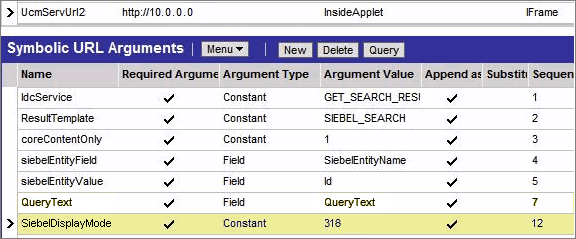
Description of the illustration ''extraparams2.gif''
-
-
For business objects that require the alternate display mode, change the symbolic URL to point to the secondary symbolic URL.
2.7.2.3 Calculate Values for Custom Buttons
If you have added custom buttons to the IFrame (as described in Section 2.7.1) and want to hide them in an alternate display mode, include their values in the integer calculation.
The following resource adds the buttons (custombtn1 and custombtn2) to the EnumObj javascript object and the framework calculates their values at run time:
js_custom_button_visibility_handler
<@dynamichtml js_custom_button_visibility_handler@>
<$include super.js_custom_button_visibility_handler$>
NAME_ENUM.CUSTOMBTN1="CUSTOMBTN1",
NAME_ENUM.CUSTOMBTN2="CUSTOMBTN2",
EnumObj.add(NAME_ENUM.CUSTOMBTN1,"customBtn1",IMG_ENUM.BUTTON);
EnumObj.add(NAME_ENUM.CUSTOMBTN2,"customBtn2",IMG_ENUM.BUTTON);
<@end@>
The following illustration displays the custom buttons and their calculated values:

Description of the illustration ''integer2.gif''
2.7.3 Change Display Colors
To change the background, highlighted row, or hover row in IFrame, create a component and override the following resources:
-
css_adapter_background_styling
-
css_adapter_row_styling
css_adapter_background_styling
In the following lines, specify another background color for the adapterBackgroundColor idoc variable (hexidecimal code recommended). The super include line must be present.
<@dynamichtml css_adapter_background_styling@>
<$adapterBackgroundColor="#346a2a"$>
<$include super.css_adapter_background_styling$>
<@end@>
In the following lines, change the row colors by specifying different colors for the selectedRowColor and highlightedRowColor idoc variables. The super include line must be present.
<@dynamichtml css_adapter_row_styling@>
<$selectedRowColor="#eac5a6"$>
<$highlightedRowColor="#bdc1a3"$>
<$include super.css_adapter_row_styling$>
<@end@>
2.8 Uninstalling the Adapter
Follow the steps listed in these sections to uninstall the adapter:
2.8.1 Disable Adapter Components on Content Server
Follow these steps to disable the following adapter components on the Content Server:
-
Log in to Content Server as an administrator.
-
Select Admin Server from the Administration menu.
The Component Manager page is displayed.
-
Scroll to the Integration components section.
-
Deselect the Siebel adapter components to disable them.
-
SiebelEcmIntegration
-
SiebelIntegrationSearchDisplay
-
SiebelSearchExtension
-
SiebelSearchExtraParams
-
SiebelFilter
(For details about these components, see Section 2.2.3)
-
-
Click Update.
-
Restart Content Server.
Note:
For information about restarting methods, see the section on starting, stopping, and restarting Content Server in the Oracle Fusion Middleware Administering Oracle WebCenter Content.
2.8.2 Uninstall Siebel Components
Uninstalling Siebel adapter components includes activating the default Siebel File Attachment Applets that were disabled during adapter configuration, and deactivating the applets the SIF file added for the adapter configuration. See Section A.2.